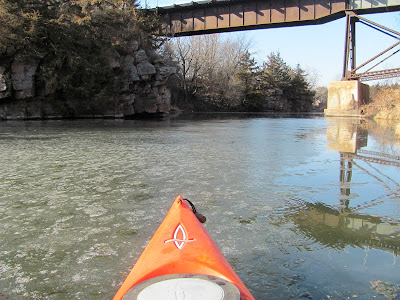 |
| Dave Finck Heading South on Lake Alvin |
Today was one of those glorious fall days here on the
northern plains. The morning
temperature was in the high 30s, the sun was bright, and the winds were
calm. It was an ideal day to check
out Lake Alvin as the natural environment begins to shift into the slower pace
of winter and before ice forms on the lake.
 |
| Dave Finck |
I loaded up my kayak and headed out to Lake Alvin, arriving
at 10:00 a.m. in the public access area located on the southwestern end of this
100-acre lake. Dave Finck had
arrived at the lake an hour earlier, and he came down from the northern end of
the lake just as I set out from shore. We had miscommunicated our rendezvous time.
 |
| Entrance into Nine-Mile Creek |
As nearly always, we headed first up into Nine-Mile Creek,
which feeds into the lake from the south.
It was difficult to get past the shallow flats that have resulted from a
receding shoreline, but we managed to grab hold of a bush and pull our kayaks
around the bend and into a deeper channel heading into the flow of the creek.
 |
| Dave Finck in Nine Mile Creek |
We proceeded upstream on Nine-Mile Creek for half a mile or
so, keeping to a narrow channel of water that allowed easy passage – as long as
we keep our eyes open for the deepest segment of the 30 foot wide creek. As with rivers, low water tends to
narrow the width of the waterway, but there is usually a remaining channel deep
enough for canoes or kayaks.
 |
| Beaver Dam on Nine Mile Creek |
After about half a mile, we came across a beaver dam that
stretched across the creek. This
was the first time that I have seen a beaver dam on Nine-Mile Creek and was
surprised.
 |
| Beaver Dam on Nine Mile Creek |
We were unable to
approach closer than about 50 feet because of the shallow draft caused by an
impoundment of water above the dam. I was disappointed in the limitation of our
upstream cruise, but it was fascinating to see the beaver dam.
 |
| Dave Finck on Lake Alvin |
Returning back downstream, we left the creek and re-entered
the main body of the lake, keeping close to the shoreline as we moved north
first along the east side and then over on the west side to the north end and
the segment that curves east into a bay. I like keeping close to the shoreline
so that I can peer into the trees and hills of the shore. This is where I am most likely to spot
any wildlife. The range of colors
and landscape along the shoreline are of great interest to me. I don’t find cruising down the middle
of the lake so compelling.
 |
| Jay Heath on Lake Alvin |
We continued around the shoreline on the north end and
entered into the spillwater channel.
The entrance into the channel is rocky, especially during this period of
low water after such a long drought.
 |
| Spillway on Lake Alvin |
Still, once past the mouth of the channel, we were able to easily move
up to the spillway itself and peer over the edge.
 |
| Spillway on Lake Alvin |
Heading back to the south end, we came across a group of
shorebirds standing around on a bare tree right on the shore. At first, I thought that they were
great blue heron, but on second thought, I am not so sure.
 |
| Waterfowl on Lake Alvin |
This was a great way to spend a fall morning, especially a
mid-week morning. I was reminded
of the benefit of retirement, a retirement that allows me the opportunity to go
out on deserted lakes during “working hours.” My time on the water this morning was about two hours; of course, Dave Finck had another hour while waiting for me.
 |
| Look of Fall on Lake Alvin |
I can’t help but wonder how many more times that I will be
able to get out in my kayak or in a canoe this season.
Dave Finck told me this morning that today
was his 68
th time out on the water this year.
For me, I think that I have been out 29
times – about average for my cruising at this time of the year.
Perhaps I will get in one or two more times on area waterways before the
kayak rack comes off the car and the equipment is put away for the next four
months.
For those interested in the changing face of Lake Alvin, there are multiple narratives posted under the "Lake Alvin" link on the right side of the blog. A complete list of the photos taken on this cruise can be found on my Flickr account at the following URL:
http://www.flickr.com/photos/jayheath/sets/72157631955182990/
























